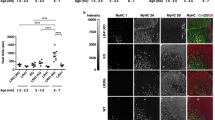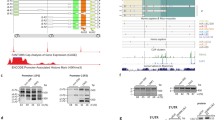Abstract
Myotonic dystrophy is the most common muscular dystrophy in adults and the first recognized example of an RNA-mediated disease. Congenital myotonic dystrophy (CDM1) and myotonic dystrophy of type 1 (DM1) or of type 2 (DM2) are caused by the expression of mutant RNAs containing expanded CUG or CCUG repeats, respectively. These mutant RNAs sequester the splicing regulator Muscleblind-like-1 (MBNL1), resulting in specific misregulation of the alternative splicing of other pre-mRNAs. We found that alternative splicing of the bridging integrator-1 (BIN1) pre-mRNA is altered in skeletal muscle samples of people with CDM1, DM1 and DM2. BIN1 is involved in tubular invaginations of membranes and is required for the biogenesis of muscle T tubules, which are specialized skeletal muscle membrane structures essential for excitation-contraction coupling. Mutations in the BIN1 gene cause centronuclear myopathy, which shares some histopathological features with myotonic dystrophy. We found that MBNL1 binds the BIN1 pre-mRNA and regulates its alternative splicing. BIN1 missplicing results in expression of an inactive form of BIN1 lacking phosphatidylinositol 5-phosphate–binding and membrane-tubulating activities. Consistent with a defect of BIN1, muscle T tubules are altered in people with myotonic dystrophy, and membrane structures are restored upon expression of the normal splicing form of BIN1 in muscle cells of such individuals. Finally, reproducing BIN1 splicing alteration in mice is sufficient to promote T tubule alterations and muscle weakness, a predominant feature of myotonic dystrophy.
This is a preview of subscription content, access via your institution
Access options
Subscribe to this journal
Receive 12 print issues and online access
$209.00 per year
only $17.42 per issue
Buy this article
- Purchase on Springer Link
- Instant access to full article PDF
Prices may be subject to local taxes which are calculated during checkout




Similar content being viewed by others

Accession codes
References
Brook, J.D. et al. Molecular basis of myotonic dystrophy: expansion of a trinucleotide (CTG) repeat at the 3′ end of a transcript encoding a protein kinase family member. Cell 68, 799–808 (1992).
Fu, Y.H. et al. An unstable triplet repeat in a gene related to myotonic muscular dystrophy. Science 255, 1256–1258 (1992).
Mahadevan, M. et al. Myotonic dystrophy mutation: an unstable CTG repeat in the 3′ untranslated region of the gene. Science 255, 1253–1255 (1992).
Liquori, C.L. et al. Myotonic dystrophy type 2 caused by a CCTG expansion in intron 1 of ZNF9. Science 293, 864–867 (2001).
Philips, A.V., Timchenko, L.T. & Cooper, T.A. Disruption of splicing regulated by a CUG-binding protein in myotonic dystrophy. Science 280, 737–741 (1998).
Mankodi, A. et al. Myotonic dystrophy in transgenic mice expressing an expanded CUG repeat. Science 289, 1769–1773 (2000).
Seznec, H. et al. Mice transgenic for the human myotonic dystrophy region with expanded CTG repeats display muscular and brain abnormalities. Hum. Mol. Genet. 10, 2717–2726 (2001).
Miller, J.W. et al. Recruitment of human muscleblind proteins to (CUG)n expansions associated with myotonic dystrophy. EMBO J. 19, 4439–4448 (2000).
Kanadia, R.N. et al. A muscleblind knockout model for myotonic dystrophy. Science 302, 1978–1980 (2003).
Ho, T.H. et al. Muscleblind proteins regulate alternative splicing. EMBO J. 23, 3103–3112 (2004).
Kuyumcu-Martinez, N.M., Wang, G.S. & Cooper, T.A. Increased steady-state levels of CUGBP1 in myotonic dystrophy 1 are due to PKC-mediated hyperphosphorylation. Mol. Cell 28, 68–78 (2007).
Savkur, R.S., Philips, A.V. & Cooper, T.A. Aberrant regulation of insulin receptor alternative splicing is associated with insulin resistance in myotonic dystrophy. Nat. Genet. 29, 40–47 (2001).
Mankodi, A. et al. Expanded CUG repeats trigger aberrant splicing of ClC-1 chloride channel pre-mRNA and hyperexcitability of skeletal muscle in myotonic dystrophy. Mol. Cell 10, 35–44 (2002).
Charlet-Berguerand, N. et al. Loss of the muscle-specific chloride channel in type 1 myotonic dystrophy due to misregulated alternative splicing. Mol. Cell 10, 45–53 (2002).
Jungbluth, H., Wallgren-Pettersson, C. & Laporte, J. Centronuclear (myotubular) myopathy. Orphanet J. Rare Dis. 3, 26 (2008).
Laporte, J. et al. A gene mutated in X-linked myotubular myopathy defines a new putative tyrosine phosphatase family conserved in yeast. Nat. Genet. 13, 175–182 (1996).
Bitoun, M. et al. Mutations in dynamin 2 cause dominant centronuclear myopathy. Nat. Genet. 37, 1207–1209 (2005).
Nicot, A.S. et al. Mutations in amphiphysin 2 (BIN1) disrupt interaction with dynamin 2 and cause autosomal recessive centronuclear myopathy. Nat. Genet. 39, 1134–1139 (2007).
Lee, E. et al. Amphiphysin 2 (BIN1) and T tubule biogenesis in muscle. Science 297, 1193–1196 (2002).
Peter, B.J. et al. BAR domains as sensors of membrane curvature: the amphiphysin BAR structure. Science 303, 495–499 (2004).
Razzaq, A. et al. Amphiphysin is necessary for organization of the excitation-contraction coupling machinery of muscles, but not for synaptic vesicle endocytosis in Drosophila. Genes Dev. 15, 2967–2979 (2001).
Dansithong, W. et al. MBNL1 is the primary determinant of focus formation and aberrant insulin receptor splicing in DM1. J. Biol. Chem. 280, 5773–5780 (2005).
Hino, S. et al. Molecular mechanisms responsible for aberrant splicing of SERCA1 in myotonic dystrophy type 1. Hum. Mol. Genet. 16, 2834–2843 (2007).
Yuan, Y. et al. Muscleblind-like 1 interacts with RNA hairpins in splicing target and pathogenic RNAs. Nucleic Acids Res. 35, 5474–5486 (2007).
Kino, Y. et al. MBNL and CELF proteins regulate alternative splicing of the skeletal muscle chloride channel CLCN1. Nucleic Acids Res. 37, 6477–6490 (2009).
Kalsotra, A. et al. A postnatal switch of CELF and MBNL proteins reprograms alternative splicing in the developing heart. Proc. Natl. Acad. Sci. USA 105, 20333–20338 (2008).
Kanadia, R.N. et al. Reversal of RNA missplicing and myotonia after muscleblind overexpression in a mouse poly(CUG) model for myotonic dystrophy. Proc. Natl. Acad. Sci. USA 103, 11748–11753 (2006).
Teplova, M. & Patel, D.J. Structural insights into RNA recognition by the alternative-splicing regulator muscleblind-like MBNL1. Nat. Struct. Mol. Biol. 15, 1343–1351 (2008).
Tronchère, H. et al. Production of phosphatidylinositol 5-phosphate by the phosphoinositide 3-phosphatase myotubularin in mammalian cells. J. Biol. Chem. 279, 7304–7312 (2004).
Ueda, H. et al. Decreased expression of myotonic dystrophy protein kinase and disorganization of sarcoplasmic reticulum in skeletal muscle of myotonic dystrophy. J. Neurol. Sci. 162, 38–50 (1999).
Goyenvalle, A. et al. Rescue of dystrophic muscle through U7 snRNA-mediated exon skipping. Science 306, 1796–1799 (2004).
Muller, A.J. et al. Targeted disruption of the murine Bin1/amphiphysin II gene does not disable endocytosis but results in embryonic cardiomyopathy with aberrant myofibril formation. Mol. Cell. Biol. 23, 4295–4306 (2003).
Al-Qusairi, L. et al. T tubule disorganization and defective excitation-contraction coupling in muscle fibers lacking myotubularin lipid phosphatase. Proc. Natl. Acad. Sci. USA 106, 18763–18768 (2009).
Kimura, T. et al. Altered mRNA splicing of the skeletal muscle ryanodine receptor and sarcoplasmic/endoplasmic reticulum Ca2+-ATPase in myotonic dystrophy type 1. Hum. Mol. Genet. 14, 2189–2200 (2005).
Osborne, R.J. et al. Transcriptional and post-transcriptional impact of toxic RNA in myotonic dystrophy. Hum. Mol. Genet. 18, 1471–1481 (2009).
Yuan, S. et al. Biogenesis of transverse tubules: immunocytochemical localization of a transverse tubular protein (TS28) and a sarcolemmal protein (SL50) in rabbit skeletal muscle developing in situ. J. Cell Biol. 110, 1187–1198 (1990).
Dowling, J.J. et al. Loss of myotubularin function results in T tubule disorganization in zebrafish and human myotubular myopathy. PLoS Genet. 5, e1000372 (2009).
Toussaint, A. et al. Defects in amphiphysin 2 (BIN1) and triads in several forms of centronuclear myopathies. Acta Neuropathol. 121, 253–266 (2010).
Wilmshurst, J.M. et al. RYR1 mutations are a common cause of congenital myopathies with central nuclei. Ann. Neurol. 68, 717–726 (2010).
Mouisel, E. et al. Outcome of acetylcholinesterase deficiency for neuromuscular functioning. Neurosci. Res. 55, 389–396 (2006).
Acknowledgements
We thank T. Cooper (Baylor College of Medicine) for the gift of the β-globin 4.11.12, DMPKS, DT960 and tgCUGBP1 plasmids, L. Ranum (University of Minnesota) for the gift of the CCTG300 expression plasmid, C. Branlant (CNRS) for the gift of the pGEX-MBNL1Δ101 vector, M. Swanson (University of Florida) for the gift of the pGEX-6P-MBNL1-His vector, P. Hawkins (Babraham Research Campus) for the gift of the GFP-PH domain of PLCg and GFP-PX domain of P40 constructs, O. Gozani (Stanford University) for the gift of the GFP-PHD domain of ING2 vector, Z. Xue (Université Paris 7) for the gift of the synemin-specific antibody, I. Marty (INSERM) for the gift of the RYR1-specific antibody, M. Swanson (University of Florida), G. Gourdon (INSERM) and C. Thornton (University of Rochester) for the gift of RNA from skeletal muscles of MBNL1ΔE3, DM300 and HSALR mice, respectively, the IGBMC facilities for assistance, J. Lainé, G. Butler-Browne and all members of the French DM Network for fruitful discussion. This work was supported by INSERM AVENIR (N.C.-B.), Agence nationale de la recherche GENOPAT 07-942 (N.C.-B.), 08-005 (J.L.) and BLANC 07-065 (J.L.), Association Française contre les Myopathies MNM1 12982 (N.C.-B.), 12570 and 14269 (D.F.), 12576 and 14058 (J.L.), Fondation pour la Recherche Médicale 20071210538 (J.L.), Japan Society for the Promotion of Science KAKENHI 20590998 (M.P.T.) and a European Molecular Biology Organization long-term fellowship (Y.I.).
Author information
Authors and Affiliations
Contributions
Experiments were carried out by C.F., A.F.K., C.H., S.V., Y.I., A.T., V.T., A.V., A.F., N.M., Y.K., R.T., V.F., G.P., C.B.-L. F.D. and M.-C.H. Bioinformatic analyses were done by P.d.l.G., D.D., C.T. and D.A. Clinical samples and patient data were from A.L.d.M., N.S., A.L., B.U., B.S., M.P.T., I.N., G.B. and D.F. Data were collected and analyzed by N.M., C.T., D.A., L.G., P.Z., I.N., M.P.T., B.U., B.S., G.B., J.L., D.F. and N.C.-B. The study was designed, coordinated and written by D.F. and N.C.-B.
Corresponding author
Ethics declarations
Competing interests
The authors declare no competing financial interests.
Supplementary information
Supplementary Text and Figures
Supplementary Figures 1–5 and Supplementary Methods (PDF 1360 kb)
Rights and permissions
About this article
Cite this article
Fugier, C., Klein, A., Hammer, C. et al. Misregulated alternative splicing of BIN1 is associated with T tubule alterations and muscle weakness in myotonic dystrophy. Nat Med 17, 720–725 (2011). https://doi.org/10.1038/nm.2374
Received:
Accepted:
Published:
Issue Date:
DOI: https://doi.org/10.1038/nm.2374
This article is cited by
-
MYTHO is a novel regulator of skeletal muscle autophagy and integrity
Nature Communications (2023)
-
Establishment of quantitative and consistent in vitro skeletal muscle pathological models of myotonic dystrophy type 1 using patient-derived iPSCs
Scientific Reports (2023)
-
Stretching muscle cells induces transcriptional and splicing transitions and changes in SR proteins
Communications Biology (2022)
-
Reversal of RNA toxicity in myotonic dystrophy via a decoy RNA-binding protein with high affinity for expanded CUG repeats
Nature Biomedical Engineering (2022)
-
The Mechanistic Role of Bridging Integrator 1 (BIN1) in Alzheimer’s Disease
Cellular and Molecular Neurobiology (2021)


